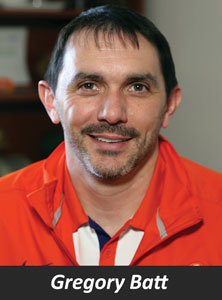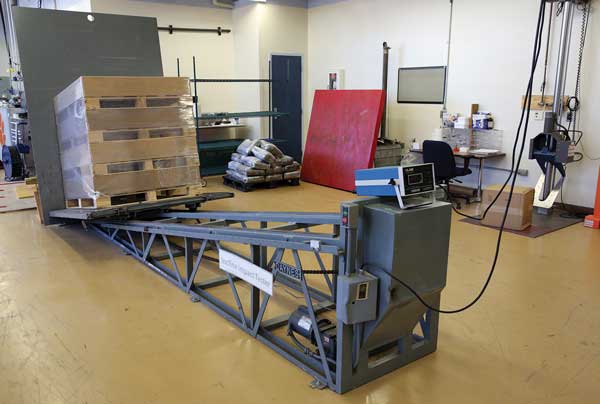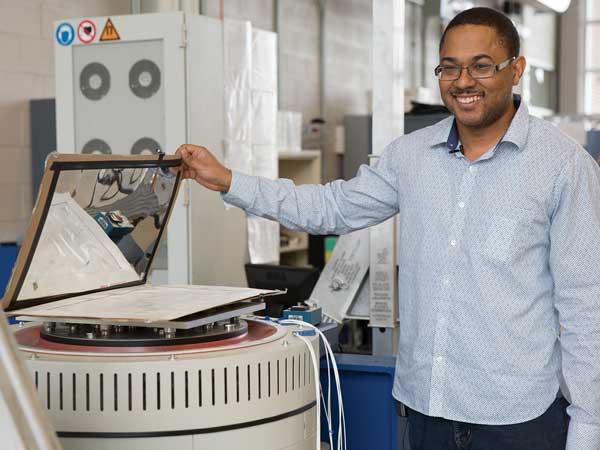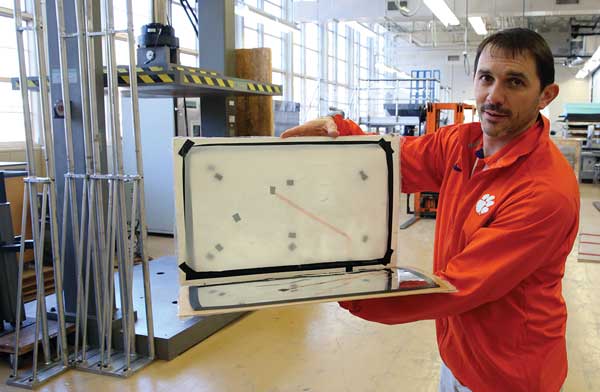The Smart Evolution of Food Packaging
INSIDE ACADEMIA
Since humans first began storing and transporting food, the main objective of food packaging has been containment. Modern packaging for food is designed not only for containment but also to protect food products from damage, increase shelf life, and facilitate their transport and portability. Consequently, food packaging has evolved from containers made solely with natural materials to a variety of packaging materials designed to transform how food is contained and distributed. Recent advances in technology are poised to further revolutionize food packaging in ways that will benefit both consumers and food manufacturers. At the forefront of the food packaging revolution is Clemson University, where researchers are investigating and developing new technologies that will make packaging smarter, more intuitive, and more effective.
Packaging for Efficiency
 For some time, the focus of the packaging industry was not only to package and protect food products but also to do so in an efficient manner, using less packaging materials and utilizing materials that are more environmentally friendly. “For the past decade, I’d say the focus has been ‘reduce, reduce, reduce,’” says Gregory Batt, an assistant professor in the department of food, nutrition, and packaging sciences and director of the Sonoco Package Testing Laboratory at Clemson. Prior to working for Clemson, Batt spent years working in the outdoor sports industry, designing kayaks, which, he reasons, is “really a package for human beings going down the river.” His experience in designing compact sports equipment that protects precious human cargo served as an excellent foundation for designing efficient packaging that protects food. “My focus is on the physical protection of packaged products, and if you extend that to food products, protecting them as we unitize or package food products and then combine them into unitized loads. These pass through various channels throughout the distribution environment,” Batt says. “As we look at the physical forces of shock and vibration and compressive forces that packaged food products will undergo in the distribution environment [and] understand what those are more clearly, we can tailor the design of packaging to meet those.”
For some time, the focus of the packaging industry was not only to package and protect food products but also to do so in an efficient manner, using less packaging materials and utilizing materials that are more environmentally friendly. “For the past decade, I’d say the focus has been ‘reduce, reduce, reduce,’” says Gregory Batt, an assistant professor in the department of food, nutrition, and packaging sciences and director of the Sonoco Package Testing Laboratory at Clemson. Prior to working for Clemson, Batt spent years working in the outdoor sports industry, designing kayaks, which, he reasons, is “really a package for human beings going down the river.” His experience in designing compact sports equipment that protects precious human cargo served as an excellent foundation for designing efficient packaging that protects food. “My focus is on the physical protection of packaged products, and if you extend that to food products, protecting them as we unitize or package food products and then combine them into unitized loads. These pass through various channels throughout the distribution environment,” Batt says. “As we look at the physical forces of shock and vibration and compressive forces that packaged food products will undergo in the distribution environment [and] understand what those are more clearly, we can tailor the design of packaging to meet those.”
 But recently, the focus of the food packaging industry has changed. “Now I see a shift … to not just the efficiency of the packaging but also the efficacy of that packaging,” Batt reveals. “There is a [new] focus on the performance of that packaging and making sure that while we can reduce, … we need to do so intelligently so that we don’t sacrifice the product itself and lose it to damage in the distribution environment.” Losing food to damage during distribution encompasses more than just physical injury (i.e., crushed, smashed, or crumbling food) caused by packages being jostled around. Temperature, moisture content, oxygen level, and microorganisms are also factors that can adversely affect food during transport and distribution, making products spoil or otherwise rendering them unsafe before they reach supermarket shelves and consumer pantries. The variety of factors that can degrade food after it has been packaged has given rise to packaging with levels of functionality that extend beyond mere containment: smart/intelligent packaging and active packaging.
But recently, the focus of the food packaging industry has changed. “Now I see a shift … to not just the efficiency of the packaging but also the efficacy of that packaging,” Batt reveals. “There is a [new] focus on the performance of that packaging and making sure that while we can reduce, … we need to do so intelligently so that we don’t sacrifice the product itself and lose it to damage in the distribution environment.” Losing food to damage during distribution encompasses more than just physical injury (i.e., crushed, smashed, or crumbling food) caused by packages being jostled around. Temperature, moisture content, oxygen level, and microorganisms are also factors that can adversely affect food during transport and distribution, making products spoil or otherwise rendering them unsafe before they reach supermarket shelves and consumer pantries. The variety of factors that can degrade food after it has been packaged has given rise to packaging with levels of functionality that extend beyond mere containment: smart/intelligent packaging and active packaging.
 Packaging for Efficacy
Packaging for Efficacy
While it may seem to some that the terms ‘intelligent packaging’ and ‘active packaging’ are interchangeable, they are not identical concepts. “It’s a little confusing,” says Kay Cooksey, a professor in Clemson’s department of food, nutrition, and packaging sciences. “Active packaging is technically supposed to be something that senses a change in the package and then makes [an adjustment] by trying to improve the quality or sensory or detects something present. Smart or intelligent [packaging] just signals and doesn’t do anything but just tell you something has happened.” There are several examples of food packaging that incorporates intelligent packaging technologies. “Some of these smart or intelligent devices as they apply to food packaging would be devices that could measure temperature or relative humidity of the ambient environment that a food product may pass through. Other devices might allow GPS tracking of the location of those [packages] at any given time,” Batt explains. “There are devices that could even measure acceleration or some of the rotational pitch and roll that a unitized load or a packaged case of a product might go through.”
The goal of both intelligent and active food packaging is to extend the shelf life, quality, and safety of packaged foods and beverages. “Much of the technology that we work with now and consider is passive in nature. It is recording and tracking information that can then, at the point of delivery, be downloaded and analyzed after the fact,” Batt says. Intelligent package sensors can immediately let manufacturers, store managers, and consumers know the status of a product; this helps improve the quality and safety of food products. “We lose a lot of food because we don’t know for sure if it’s spoiled, and all of the use-by dates and everything are very vague. This way, maybe we would have the package actively assure the consumer that [a food product] is safe to eat,” Cooksey says.
Still, monitoring adverse changes in food products without doing anything about it may seem to address only half of the problem, which is where active packaging technology comes in. Commercial forms of active packaging technology are sachets or pads that absorb oxygen, carbon dioxide, or moisture. “The most common active packaging is the oxygen sachets,” Cooksey points out. “There’s some you don’t even know is there like the pasta lidding that goes on fresh pasta packages; that’s oxygen-scavenging lidding material. It does it without you[r] even knowing it. Moisture absorbers and oxygen scavengers and ethylene-scavenging material are all commercial.” Cooksey and her laboratory team are working to expand the capabilities of active packaging. “To get active and intelligent packaging together would be more efficient. It would allow the technology to work better together. So if something is sensing that a pathogen is present in a food, well what difference does it make that we know it’s there?” she wonders. “We would want to get rid of it. The idea is to be able not only to detect that it’s there but also have the package be able to actively get rid of it.” One of the ideas emerging from the Cooksey laboratory is an active package that not only detects the presence of microorganisms in food but also kills them. “For food, we’ve been working on trying to get spoilage indicators and something that’s antimicrobial at the same time so that you have active and intelligent all in one. We’re getting closer, but we’re not there yet,” Cooksey reveals.
‘Batteries Not Included’
Advancing the technological abilities of intelligent and active packaging also requires advancing the methods to power them. “Most of these devices are powered with batteries. As the technology improves, with respect to the recording devices themselves, things are getting smaller and smaller, but battery sizes have not changed significantly,” Batt explains. “There have been some advances in battery technology, but [they] have been outpaced by the technology involved in the sensors and the circuit boards used to store and transmit data. [In addition,] they’re still large with respect to the devices that are recording. They’re heavy, they take up space, and this restricts how small some of these devices can actually get.”
 Moreover, batteries eventually wear out, which is why Batt and fellow Clemson alum James Gibert have been exploring a new way to power the devices embedded in intelligent and active food packaging. Gibert, an assistant professor of mechanical engineering at Purdue University, completed his bachelor’s, master’s, and doctorate degrees at Clemson University and was in some of the same graduate courses as Batt. “Greg started in my lab when I was a master’s student, and we were lab mates, and we became friends. During that time, we worked together, and I graduated,” Gibert says. “He was doing his PhD work in viscoelastic responses in polymer materials and I had a background in viscoelasticity, so I served as a post-doc on some of his project work and an informal advisor. After he graduated, we continued our partnership, and we published numerous papers on the shock performance of polymer foams and the vibration response of polymer foams.”
Moreover, batteries eventually wear out, which is why Batt and fellow Clemson alum James Gibert have been exploring a new way to power the devices embedded in intelligent and active food packaging. Gibert, an assistant professor of mechanical engineering at Purdue University, completed his bachelor’s, master’s, and doctorate degrees at Clemson University and was in some of the same graduate courses as Batt. “Greg started in my lab when I was a master’s student, and we were lab mates, and we became friends. During that time, we worked together, and I graduated,” Gibert says. “He was doing his PhD work in viscoelastic responses in polymer materials and I had a background in viscoelasticity, so I served as a post-doc on some of his project work and an informal advisor. After he graduated, we continued our partnership, and we published numerous papers on the shock performance of polymer foams and the vibration response of polymer foams.”
 Gibert and Batt are devising ways to harvest triboelectric energy and convert it to electricity to power a device that will provide energy for smart devices. Triboelectricity is the energy emitted when two materials come in frictional contact—essentially, it is a form of static electricity. “Contact electrification has been around since static electricity. It’s only recently that we found that we could do [useful things] with it,” Gibert says. “This is a power source that varies, depending on input,” Batt adds. “In this context, within the distribution environment, where we have packaged products that are, say, in the back of a truck going down a road or in the back of an intermodal container going over rails in railcars, the input would be a continuous vibration input. That will produce a continuous electrical response or energy that we can harvest.”
Gibert and Batt are devising ways to harvest triboelectric energy and convert it to electricity to power a device that will provide energy for smart devices. Triboelectricity is the energy emitted when two materials come in frictional contact—essentially, it is a form of static electricity. “Contact electrification has been around since static electricity. It’s only recently that we found that we could do [useful things] with it,” Gibert says. “This is a power source that varies, depending on input,” Batt adds. “In this context, within the distribution environment, where we have packaged products that are, say, in the back of a truck going down a road or in the back of an intermodal container going over rails in railcars, the input would be a continuous vibration input. That will produce a continuous electrical response or energy that we can harvest.”
The type of energy generated by triboelectricity is neither colossal nor continuous, so triboelectric energy would likely not be used to power the refrigeration system of a truck transporting perishable food. “Whatever application we use it for, we have to design the device that’s actually going to power in conjunction with the power source,” Batt discloses. Triboelectric energy can be used to power two types of devices: those that can function with intermittent power input and those that require continuous power. It could therefore be used to power sensors monitoring the temperature of perishable items or scavenging devices. “These are very low-power devices,” Batt declares. “As you move from that to devices that are capable of recording acceleration and storing that data, the power demand goes up. As we move even further to GPS devices that consume a lot more power, those are at a level where triboelectric energy is not there—yet.” “We’re at the early stages of technological exploration, and we’re not the only lab that’s doing this,” Gibert clarifies, “but we’re trying to put a certain rigor to the development of this technology.”
That rigor is fueled, in part, by the advanced facilities at Clemson that are dedicated to packaging science. “Packaging science deals with the science of packaging products of which there’s a wide range—from food products to automotive products to consumer goods and electronic products. So we have to have content in our program to educate students over the wide range of the sciences that touch all of these things,” Batt says. Clemson’s packaging program focuses on four areas: food packaging, packaging materials, package design, and package distribution/transportation. “I’m most intimately involved in transportation distribution, protective packaging, [and] packaging dynamics,” Batt asserts, “so shock, vibration, and compressive forces as well as environmental conditions such as temperature and relative humidity that might exist in the distribution environment.” As Batt, Gibert, Cooksey, and other professors in the packaging program at Clemson continue their research and thoughtful instruction, the future of food packaging is not only bright but also active and smart.
